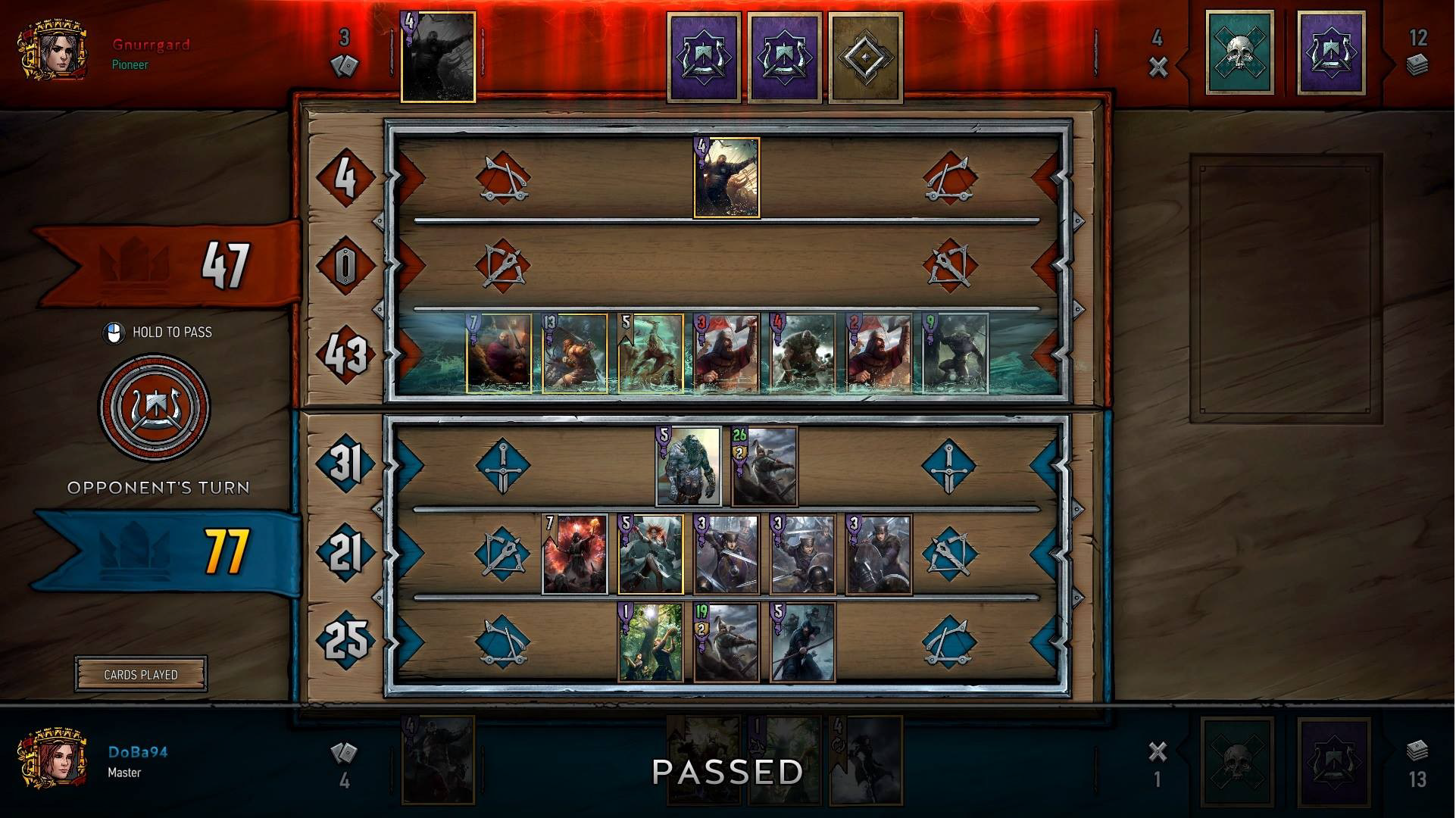Gnurrgard's Gametalk: Resources Part 1
Resources - Part 1: A Guest Piece by Gnurrgard
Introduction
How do I use spies/Ciri? - This is probably one of the most frequently asked questions from new players. Giving your opponent 10+ stats doesn’t seem right when the goal of the game is to have more points than your opponent. Intermediate players will often answer with “Just play it when you‘re about to lose the round or play it when you won the first round.” This behavior is something I also see very often on ladder: my opponent playing Ciri while he is behind, followed by me passing and him still being at an insurmountable point disadvantage which forces him to pass, too. He used a valuable gold card just to test if I intended to continue the round, which I obviously didn’t.

As you can see here, the Ciri was not exerting any pressure, letting the axemen player pass comfortably.
I believe the best use of spies and Ciri is to put pressure on and punish an opponent that fails to keep up with you on tempo. The reason why Ciri is a gold card (and rightfully so) is that in this situation, she further advances your game state as opposed to closing the gap between you and your opponent. When I thought about this, I realized that you‘re basically trading tempo for card advantage.
In Gwent, we‘re trading resources all the time. Knowing what resources we have at our disposal, understanding how they interact with each other and how you can use them to ultimately win two rounds is a big step towards being a great player.
This article will be split in two parts: The first one will cover the resources and how I would define them while in the second part we will take a look at how they interact with each other.

This Ciri is putting the axemen player into a dilemma where he either has to go down 3 cards or lose with a card disadvantage
Value
Let‘s start off with the most prominent resource. Value is the number of points on the table. The player with the most value wins the round. In regards to a card, a cards value is the number of points it achieved at the end of the round. Let‘s take Wild Hunt Hound for example: You‘re gaining 4 value initially and up to 2 value per turn through the frost effect.
The value of removal is harder to evaluate: Let‘s assume you use Alzur’s Thunder on an Arachas Behemoth. You initially gain 5 value, but you‘re also denying your opponent value out of his card.
Rounds
In “The Theory of Everything,” Patrick Chapin classifies various in-game resources. One of these classifications is “Resources you begin the game with but do not gain naturally.” In card games like Magic and Hearthstone, these are your health points. This category is often overlooked as a resource because in these games, the primary win-condition is to diminish this resource for your opponent. As your opponent is trying to do the same to you, you are incentivized to protect it.
But technically you only need 1 health point to not lose the game.
Similarly in Gwent, you are allowed to lose 1 round over the course of the game, why not try to benefit of this fact?
“Many players make the mistake of thinking their life total matters beyond the fact when it is zero you are dead. It is true that it matters when you are using your life as a resource but this is exactly the point.” -Patrick Chapin about life as a resource.
Tempo
A term most are familiar with from mana-based games, tempo measures the impact a card has the moment it is played. Playing Crones is a 20-tempo play.
If we extend the term to players, tempo describes the current point difference.
Cards
To generate value and tempo, we need cards. The more cards we have, the more value we are able to make in a round. But more importantly, having more cards gives us options. In a game that revolves around getting more points than the opponent, being able to choose between multiple cards is invaluable to maximize our value. An additional benefit of having more cards than your opponent is being able to play the last card in a round. Since the nature of Gwent is highly reactive, having the last say is often game-deciding.
One distinction we have to make to other games like Yu-Gi-Oh! for example is that we only count cards in our hands as opposed to also counting cards on the board. Those cards have already been converted to tempo and/or value.
Card Quality
When I started writing this article, I only had the aforementioned resources in mind. But when I worked on the interactions and trade-offs between the resources, it became apparent that your ability to do power plays is limited and can be converted into other resources, making it a resource itself.
Two of the most prominent power plays in the current metagame are Crones and Reaver Hunters, for example. These cards have a high concentration of value distributed over just a few cards.
Bringing the game into a state where your opponent’s card quality is lower than yours is also the incentive when you‘re bleeding your opponent .

You normally don’t want to face too many of them in round 3!
Conclusion
Resources and resource management is something that is integral to any card game. We now know which resources we have in Gwent and just by being aware of them we can get a better grasp of what is going on in the game. Ideally you want to make your plays with a specific resource in mind.
In Part 2 we will take a look at how to convert these resources into each other and how we use these interactions to execute our gameplan for a victorious outcome.
